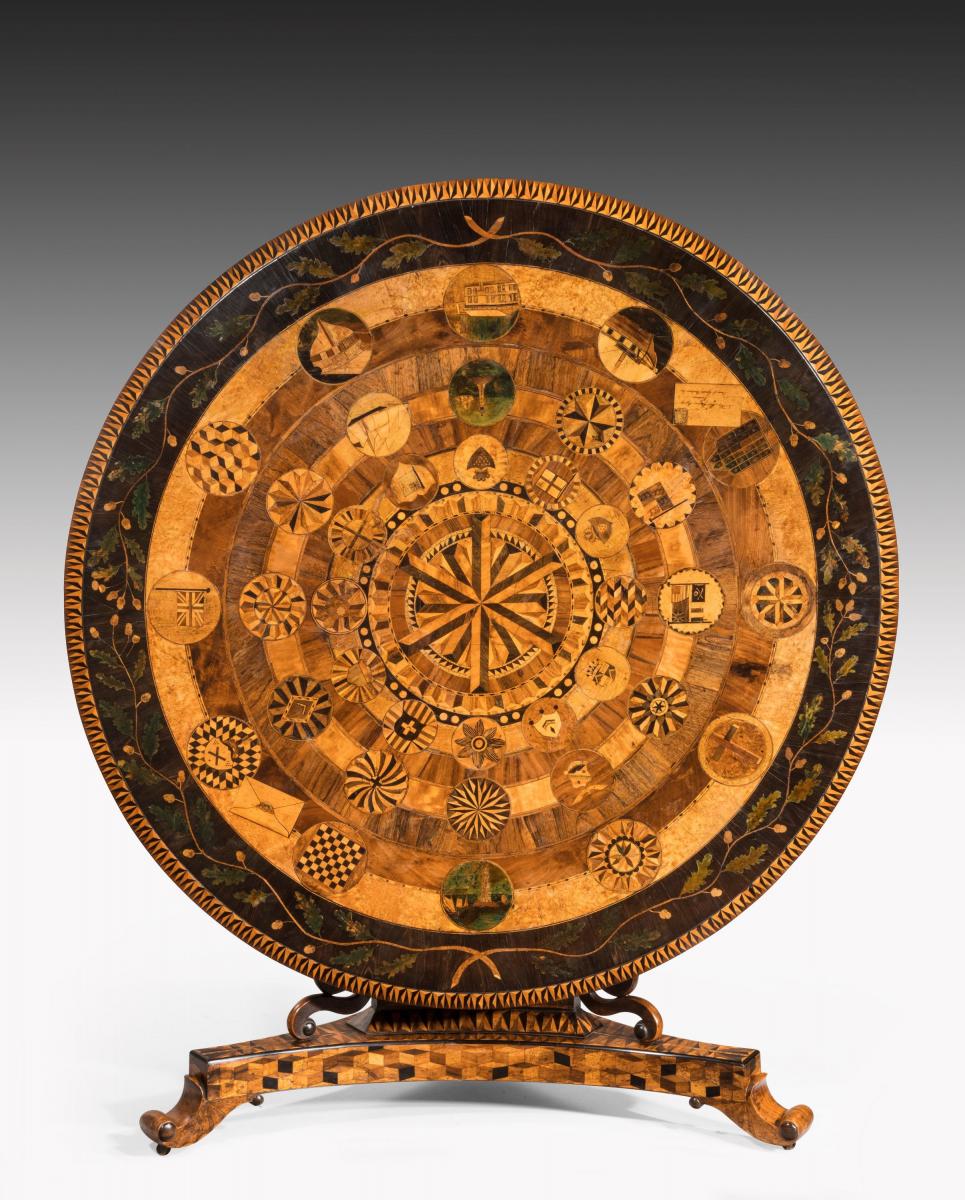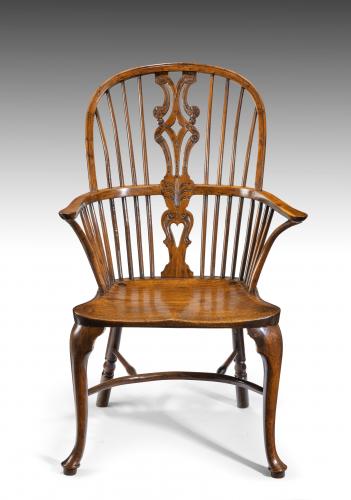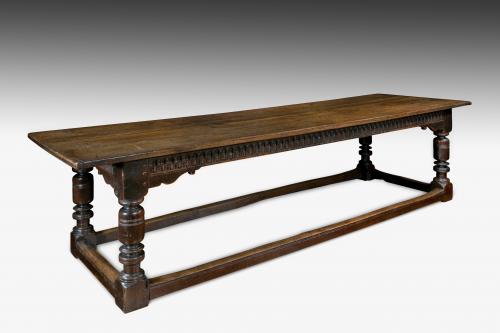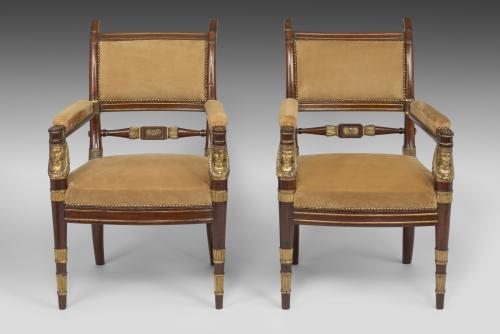

This object is eligible for a Certificate of BADA Provenance
The BADA Standard
- Since 1918, BADA has been the leading association for the antiques and fine art trade
- Members are elected for their knowledge, integrity and quality of stock
- Our clients are protected by BADA’s code of conduct
- Our dealers’ membership is reviewed and renewed annually
- Bada.org is a non-profit site: clients deal directly with members and they pay no hidden fees
JAMAICA, circa 1846-51
A highly important mid nineteenth century veneered centre table, with a profusely inlaid top which incorporates many exotic tropical hardwoods including: rosewood; ebony; birdseye maple; sabicu; satinwood; padouk; lacewood; palm wood; amboyna; and mahogany. The table top includes marquetry depictions of geometric shapes, and an array of marquetry roundels which are unusual and unique and include flags, boats, lighthouses, and a letter to Queen Victoria. The inlaid imagery offers us an insight into the society in which the table was constructed. The table represents a tour de force of Ralph Turnbull’s production; supreme in its ambition and execution and by far the most important surviving work known to come out of his workshop to date, and possibly from any furniture workshop of that period in Jamaica.
Ralph Turnbull (b.1788 - d.1865): Ralph Turnbull was the most recognised and important of all the Jamaican furniture makers of the nineteenth century. His work was highly prized then, and it continues to be the case today. This desirability is not only due to him labelling his work, but because he created a style that utilised indigenous woods of Jamaica with such dramatic effect. His method of making and decorating furniture was very much admired at the time, by patrons and fellow cabinet makers alike, and he is credited with the development of the genre of furniture that is synonymous with colonial Jamaica.
Bibliography:
John M. Cross, ‘Ralph, Cuthbert and Thomas Turnbull: a 19th-century Jamaican cabinet-making family’ in ‘Furniture History’, 2003, pp.109-120.
John M. Cross, ‘Ralph Turnbull’s 19th Century Jamaican Inlaid Centre Table’, 2018 – see text below. In this essay, John Cross writes about this centre table and the important role which its recent discovery performs in revealing new information about Ralph Turnbull's output.
Ralph Turnbull’s 19th Century Jamaican Inlaid Centre Table
By Dr John Cross
Ralph Turnbull was a fascinating furniture maker for several reasons. He labelled most of his objects and it is this reason, and his particular style, which has made his work so recognizable and prized. Even in his own lifetime his work was highly desirable and he was incredible creative in how he developed his work and reputation. There is no piece known at this time to be more a demonstration of his mastery of fine furniture making than the centre table that is the focus of this research. This article has two purposes. Firstly, to explain the imagery on the table and secondly to contextualize this table in respect of Ralph Turnbull's life and ambition in promoting his work and those who aspired to make furniture in Jamaica.
Ralph Turnbull was born in 1788, probably of Scottish birth, as he practiced as a Scottish Methodist. Where in Scotland and anything else of his early life remains unknown. It is certain he arrived in Kingston, Jamaica in 1815 and set up a furniture business with his brothers, Thomas and Cuthbert. By the mid 1820s he was working alone, it appears the brothers had fallen out, and Ralph Turnbull continued on his own until the 1830s when he worked with his brother, Thomas, again. In 1834/5 Ralph’s eldest son joined the business and later in 1844, when Ralph's youngest son, Robert came of age he too joined his father, brother and uncle in the family business. Tragically, in the same year, 1844, Ralph Turnbull senior lost both his sons. The company name remained the same, Ralph Turnbull and Sons, until the 1st January 1852 when Ralph Turnbull changed the company name to Turnbull and Lee. William Lee was Ralph Turnbull’s son-in-law by marriage to his daughter, Isabel. By 1852 Turnbull was 64 years old and a very old man, even more so by Jamaican life expectancy standards. Ralph Turnbull died in Kingston, Jamaica in 1865 at the age of 77.
The circular centre table is an extraordinary piece of Turnbull's work, which requires deciphering in order to understand its iconography and significance. The table is 52.5 inches in diameter and sits on a triangular column on a platform with carved scroll brackets. The table has a trade label on the top of the column, which states the furniture makers were Ralph Turnbull and Sons. The column and platform are veneered with an array of indigenous woods, the platform and two sides of the column have Louis Cube and other geometric designs, tarsia geometrica, the other side of the column depicting a Union Jack.
 The table top consists of twelve circles of veneered woods and patterns, with the largest outer circle containing a wreath of inlaid oak leaves and acorns. The smallest of these circles at the centre of the table depicts a six sided star with a similar larger star imposed over the top. The intervening circles are of differing woods such as Yacca and Mahoe, and several are tarsia geometrica. The circular design is interrupted by smaller circular medallions, which contain an array of designs, badges and imagery. On the table top there is also an inlaid letter addressed to Queen Victoria, with what appears to be a penny black stamp upon it. The first letters using penny blacks were not issued until May1840, signifying that the table was made after this date.
The table top consists of twelve circles of veneered woods and patterns, with the largest outer circle containing a wreath of inlaid oak leaves and acorns. The smallest of these circles at the centre of the table depicts a six sided star with a similar larger star imposed over the top. The intervening circles are of differing woods such as Yacca and Mahoe, and several are tarsia geometrica. The circular design is interrupted by smaller circular medallions, which contain an array of designs, badges and imagery. On the table top there is also an inlaid letter addressed to Queen Victoria, with what appears to be a penny black stamp upon it. The first letters using penny blacks were not issued until May1840, signifying that the table was made after this date.
It is these smaller circular medallions that are the most eye catching element of the table design. The medallions also support dating the piece and give further insight. There are thirty six discs arranged in an order that appear in a seemingly varied and random fashion. The circular medallions fall into four general groups, badges and heraldic like shields, flags, tarsia geometrica, and finally pictorial images.
The badges and heraldic shields, which number eleven (3, 9, 15, 17, 18, 21, 24, 25, 26, 27, 33 - see adjacent image for the numbering) are the most difficult to ascertain meaning. Only one of these ten designs can be read as a true heraldic shield, this being the medallion bearing the coat of arms of the Duke of Cornwall (3). The title of Duke of Cornwall is bestowed on the first son of the monarch at birth, in this instance Queen Victoria's eldest son Edward who was born on 9th November 1842. A further medallion clearly illustrates the star of the Order of the Garter (21), whether this is related to an individual remains unclear. Another of these medallions can be identified as being Christian or Masonic in its iconography (26), the square and compass symbolically depicts 'virtue' and the compasses representing 'wisdom of conduct'. If this medallion is Masonic rather than Christian the freemasonry order has a long history in Jamaica, the earliest lodge forming in the 1740s, and by 1843 one Kingston Lodge with a membership of over ninety, included Christian, Jews and 'persons of colour' amongst its membership. It is not known if Ralph Turnbull was a Mason.
To date, the other medallions bearing banners or coats of arms have been inconclusive in what they represent. These could be plantation emblems, parish badges or family heraldic shields, but none have yet to be substantiated.
The second are a grouping of five flags (6, 8, 11, 28, 36). Four of these flags are the Union Jack (28), the Ensign (6), a Union Jack with an Irish Harp (36) to one side and finally a Royal Standard (8). These four flags follow the general royal patronage of many of the medallions. The fifth flag is more intriguing, the image is of the national flags of Britain, France and America along with the pirate flag, the skull and cross bones (11). If the table was made in the late 1850s this could have been a reference to the contribution these nations made in the Opium Wars and the treatment of China in the ensuing peace settlement. However, the table dates prior to these events and perhaps this particular flag is making reference to the part these three nations played in the trading of slaves on the high seas.
The third group of eleven roundels that contain tarsia geometrica, (5, 10, 12, 14, 16, 20, 22, 23, 29, 31, 32) are interesting for two reasons. Firstly, some of these patterns and designs can be found on other known Turnbull furniture and secondly several of these designs are excellent in their execution while others, including one side of the column are poorly presented. This demonstrates that the table was made by more than one hand, probably many and possibly illustrates the table was expedited swiftly to meet a deadline or particular occasion. Ralph Turnbull was unique in applying for funds from the House of Assembly (Jamaica’s Parliament) at the time of emancipation in 1836, to fund sixty apprentices who were former slaves. This great act of charity, not only gained him the funds he needed, but also bought him to the attention of the public and in particular the Governor of Jamaica, the Marquis of Sligo, who subsequently visited and commissioned a games table for his own house in Ireland. Turnbull appears to have gained great prestige from this period that remained with him until his death. The centre table and the less skillfully executed geometric designs and other roundels, appear to represent the work of black and white apprentices, making this object much more culturally significant than its western form initially suggests.
The final grouping of discs are those that are inlaid and pictorial, tarsia a' incastro. These number eight (1, 2, 4, 7, 13, 19, 34, 35) with five being nautical, two of lighthouses and three of sailing vessels. One of the lighthouses refer to the Morant lighthouse (2), at Morant Point, which was the first cast iron lighthouse to be built in Jamaica and indeed in the western hemisphere. It was constructed in 1841. The other medallion depicts the Gibbs Hill lighthouse in Bermuda (19), which was commissioned in 1844 and built two years later in 1846.
Of the three other nautical themed roundels one illustrates a 'clipper' ship (35). The other two roundels with images of ships visualize a hull (34) and a partial image of a boat with one main mast (4). These two images and generally the six nautical themed discs could be making reference to the part that Ralph Turnbull played in the ship that was swiftly constructed in response to the lack of representation of Jamaica at the Great Exhibition of 1851. The poor presence of Jamaica at the Great Exhibition, only one exhibit was forthcoming, was mainly due to the cholera epidemic that struck the island in the second half of 1850. The island clearly was more concerned with getting the outbreak under control, than making and sending goods to London. As the epidemic finally abated, the traders and merchants of Jamaica realised too late that the great opportunity for promoting the island had past. It became particularly gauling when other, smaller islands around Jamaica, had capitalised on presenting all manner of commodities and manufactured goods. In response to this colonial embarrassment, nineteen Jamaican sponsors charter a clipper made entirely of native woods that were destined for London. This late arrival in London, at the time of the Great Exhibition, was to demonstrate the goods that the island was capable of producing and manufacturing, furniture was known to have been included in the cargo.
The other three pictorial discs, include one with a simple Christian cross (13), another having the image of a house (1), which could be of Ralph Turnbull’s workshop and the third pictorial disc is an enigma (7). What this final disc appears to represent is a window with dots and lozenges inlaid into each section, possible a reference to the Great Exhibition buildings glass façade.
This leaves one disc remaining from the thirty six, that doesn’t fall into the four themes above. This disc has at its centre a crescent moon and star (30), with a patterned border around these two motifs. The symbol of the crescent moon and star clearly has a strong reference to Islam but also could have meaning in Adinkra cosmology. The crescent moon was symbolic of loyalty, mercy and trust, whilst the star denotes we are all God’s children, so together these two motifs could be giving a message of compassion and hope.
Conclusion
We know the centre table dates from between 1846 and 1851. After 1844 Ralph Turnbull labels his work Ralph Turnbull and Sons, prior to this date his work was labeled Ralph Turnbull and Son, and in the early 1830s his label read simply Ralph Turnbull. This table carries the label Ralph Turnbull and Sons, this trade label does not alter until 1st January 1852 when a new company is formed with a trade label Turnbull and Lee. So we know the table was made between these two dates. The date line can be further narrowed with the depiction of the Bermuda lighthouse which was constructed in 1846.
 The centre table has very strong reference to the crown and royal patronage, as has been demonstrated. Many of the medallions include royal emblems whether they are the letter addressed to Queen Victoria, flags, the Garter Star, the Duke of Cornwall Heraldic shield, the band of oak leaves and acorns and even the Union Jack on one side of the column. Whether this table was destined for Queen Victoria has not been ascertained. However, it is known that a handful of important tables were sent from Jamaica to London for the Great Exhibition, several by Ralph Turnbull, whether this is one has not yet been proved.
The centre table has very strong reference to the crown and royal patronage, as has been demonstrated. Many of the medallions include royal emblems whether they are the letter addressed to Queen Victoria, flags, the Garter Star, the Duke of Cornwall Heraldic shield, the band of oak leaves and acorns and even the Union Jack on one side of the column. Whether this table was destined for Queen Victoria has not been ascertained. However, it is known that a handful of important tables were sent from Jamaica to London for the Great Exhibition, several by Ralph Turnbull, whether this is one has not yet been proved.
The centre table’s decoration appears to have been made by several hands, from apprentices to master craftsman. It has been demonstrated here Ralph Turnbull allowed young and old, African and Caucasian to participate in the completion of the finished work. Those that contributed were allowed a free hand in the designs they conceived and this explains the bewildering range of subject and symbolism of the medallions and why others still hid their meaning. The medallions depicting European, American, Caribbean, Christian, Masonic, Islamic or Adinkra cultures is astonishing, and perhaps unique, for an object of this period. The ambition of the design, the complexity of its symbolism and perhaps for what it culturally represents, makes the table exceptional. This centre table is the most important piece of furniture to come out of Ralph Turnbull’s workshop known to date and is probably the most significant Jamaican nineteenth century piece of furniture. Whilst no research has yet to substantiate this table’s provenance, it is clear this table was to represent the very best of Jamaican craftsmanship and to promote Jamaica in Britain.
Dimensions
Height: 29.5 inches (75cm); Diameter: 52.5 inches (133.5cm)Stock number
6543The BADA Standard
- Since 1918, BADA has been the leading association for the antiques and fine art trade
- Members are elected for their knowledge, integrity and quality of stock
- Our clients are protected by BADA’s code of conduct
- Our dealers’ membership is reviewed and renewed annually
- Bada.org is a non-profit site: clients deal directly with members and they pay no hidden fees




